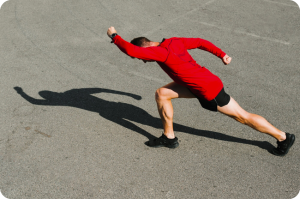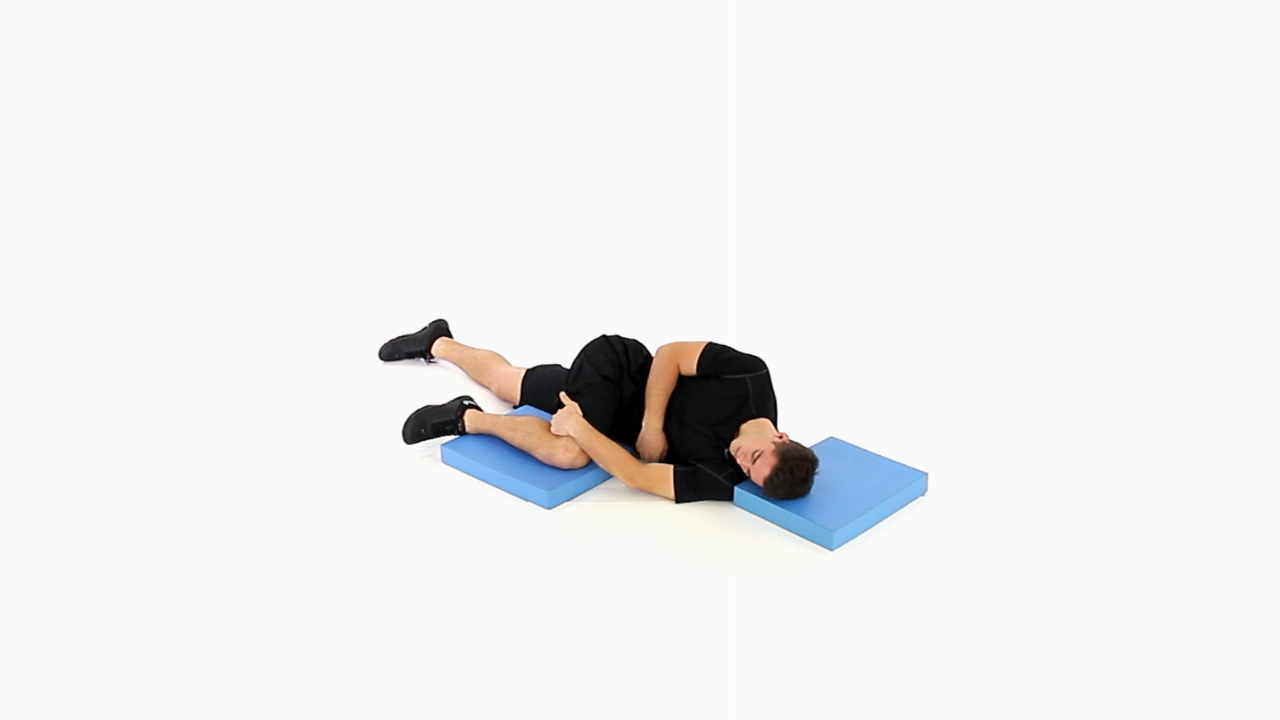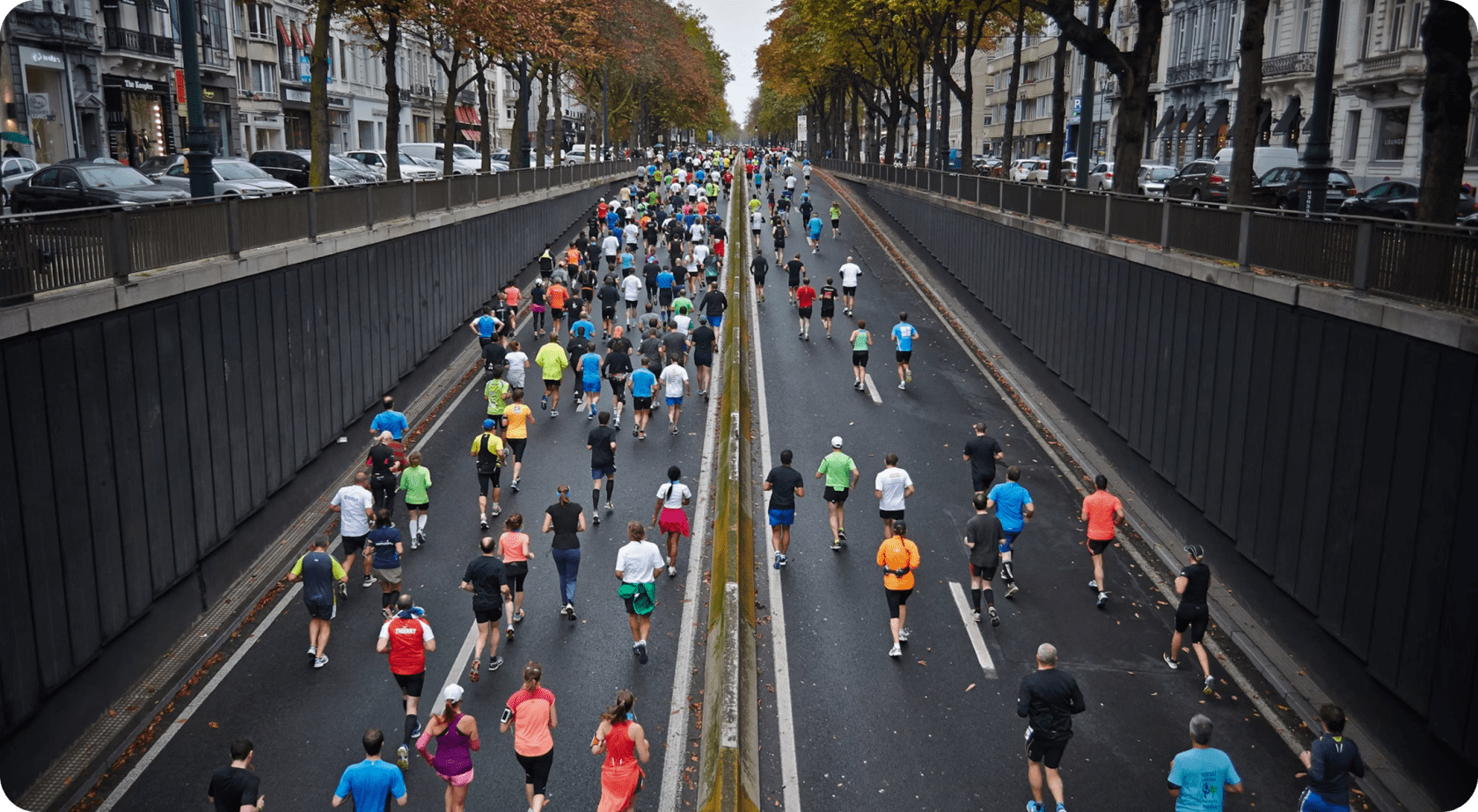Are you doing any mobility exercises before and/or after going on a run? If you don’t, keep reading to discover why you should be. And if you do, well, keep reading too, since I will be sharing some tips and my favorite exercises that helped me increase my range of motion and elevate my base running plan.
When you go for a run, even if it is just a 5k easy pace one, you are taking over 4500 steps. And with each step, if you have poor function in the feet, ankles, knees, or hips, something in that chain is going to break down over time. If those repetitive motions with misalignment or an imbalance are present, it prematurely results in wear and tear.
Here, we will go through some of the best mobility exercises that address feet and ankles, as well as your knees, thigh muscles, and hip flexors. Hopefully, by doing this mobility work, you are going to prevent injuries and improve your running performance.
But before we jump into mobility exercises for runners, we will dive deeper into mobility training aspects, including what mobility really means, how it’s different from flexibility, and why it matters so much for your overall movement quality and injury prevention.
What are Mobility Exercises?
Mobility exercises are movements designed to improve the range of motion and control of your joints.
Unlike static stretching, which focuses on lengthening muscles, a mobility workout helps your joints move more freely through their full range of motion. This is especially important for runners, as tight or restricted joints can lead to compensations, poor form, and eventually injuries.
According to the American Council on Exercise (ACE), mobility training emphasizes active body control through movements, not just passive flexibility. It involves dynamic stretches, controlled joint rotations, and stability work to ensure the muscles surrounding your joints are strong and coordinated enough to support optimal movement.
As Harvard Health notes, joint mobility tends to decline with age or as a result of prolonged sitting. Hence, it is necessary to improve it through strength and mobility training. Regular mobility workouts can help reduce the risk of pain and improve physical performance. For runners, mobility workouts are a must as their problem areas often include the ankles, hips, and thoracic spine — all of which directly affect stride length, running form, and shock absorption.
Mobility vs. Flexibility: Key Differences for Runners
While often used interchangeably, mobility and flexibility are distinct, and understanding the difference can transform your training.
1. Flexibility = Passive Length
Flexibility is the ability of a muscle/tendon to lengthen passively (e.g., holding a stretch).
For example, sitting in a static hamstring stretch (toes pointed, reaching toward your feet) is considered a flexibility exercise.
It is important to note that flexibility exercises do not help to improve strength or control in that range. Despite that, flexibility exercises are essential for runners as they help relieve tightness after runs.
2. Mobility = Active Control
Mobility is the ability to move a joint through its full range of motion with strength and stability.
For example, you are doing a deep squat while keeping your heels down and chest up (requiring ankle, hip, and core control).
The key difference between mobility and flexibility is that mobility integrates strength, neuromuscular coordination, and joint mechanics.
Why it matters for runners:
- Improves stride length (via hip extension mobility).
- Prevents injuries by teaching joints to handle load in extended ranges.
- Enhances running economy (e.g., better ankle dorsiflexion = stronger push-off).
We will explore other benefits further in this article.
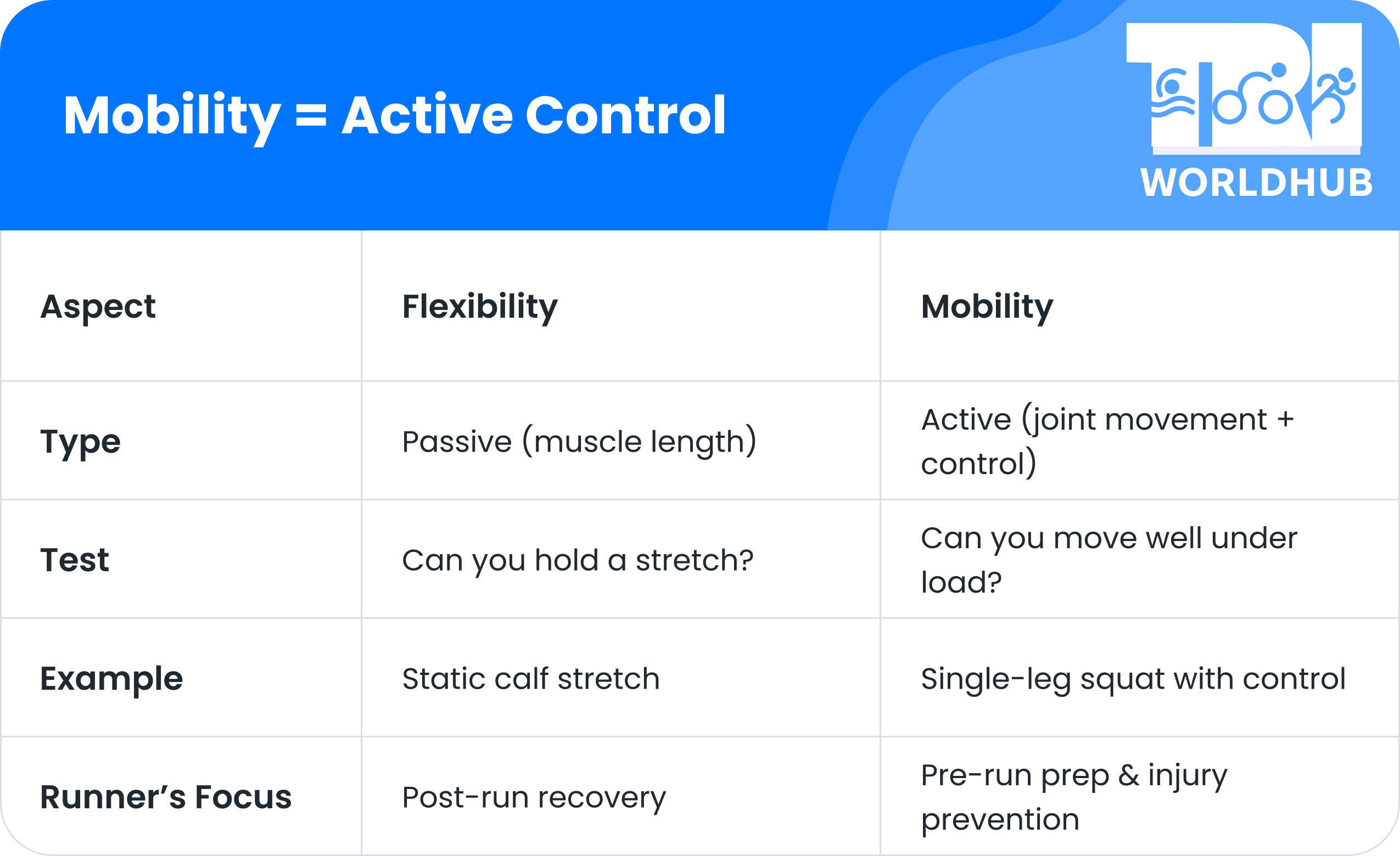
Mobility vs Flexibility: Practical Takeaways for Runners
- Pre-Run: prioritize mobility drills (e.g., leg swings, hip CARs, lunges with rotation).
- Post-Run: use static stretching for tight areas (hamstrings, hip flexors).
- Off-Days: combine both — dynamic mobility + strength (e.g., Cossack squats + loaded carries).
Benefits of Mobility Exercises for Runners
Mobility exercises are essential for runners of all levels, whether you are an elite athlete getting ready for your next Ironman race or just building your marathon training plan as a beginner.
Here are some of the main benefits of including mobility work into your training routine:
More range of motion and better stride
Mobility training increases flexibility and range of motion in key joints and muscles, including the hips, ankles, knees, and thoracic spine. This means more range of motion, a longer, more efficient stride, and smoother running mechanics so that you can run with less restriction and more power.
Less injury
Regular mobility work addresses muscle imbalances, tightness, and stiffness that come from the repetitive impact of running. Incorporating mobility into your routine prevents common running injuries like runner’s knee, plantar fasciitis, IT band syndrome, and shin splints.
Restricted ankle and hip mobility is directly linked to higher injury risk. Improving mobility in these areas can lower the risk of strains, sprains, and overuse injuries.
Faster recovery
Mobility exercises promote blood flow to the muscles, which helps with faster recovery by reducing post-run soreness and stiffness. So you feel more comfortable and ready for the next session.
Better posture, balance, and coordination
More mobility means better posture and neuromuscular control, which is key to maintaining alignment and stability while running. Better balance reduces the risk of tripping or stumbling, especially on uneven terrain, and better coordination allows you to adapt to changes in speed or surface.
More efficient running and performance
With more mobile joints and muscles, you use less energy per stride and conserve energy over longer distances. This means better endurance and overall performance.
More body awareness
Mobility training helps you become more aware of your movement patterns so you can detect and address potential issues before they become injuries. This proactive approach is key to long-term running success and enjoyment.
For optimal results, run mobility 3-5 times a week, dynamic before runs to activate the muscles, and static post-run or on rest days to improve flexibility and relieve tension.
Consistency is key. You’ll see noticeable improvements in a few weeks and significant benefits in months of regular practice. A 10-minute daily mobility routine can make a dramatic difference in how you feel and perform.
Key Areas to Target During Strength and Mobility Training
To run efficiently and stay injury-free, you need both strength (power and stability) and mobility (freedom of movement). Here are the critical areas to focus on, along with their impact on running:
1. Feet & Ankles
Your feet absorb 3–4 times your body weight with each step.
Weak or stiff ankles lead to poor shock absorption, increasing stress on knees/hips.
Key exercises:
Strength: Toe curls (towel grabs), calf raises (eccentric & single-leg), tibialis raises.
Mobility: Ankle circles, resisted dorsiflexion drills, marble pickups.
2. Knees & Quads
The knee is a “victim joint” — it suffers when hips/ankles are weak or immobile. Poor quad/glute control leads to patellar tracking issues (runner’s knee).
Key exercises:
Strength: Step-ups, Bulgarian split squats, terminal knee extensions (with bands).
Mobility: Deep knee bend holds, controlled knee CARs (circular motions).
3. Hips & Glutes
Weak glutes = hip drop (leading to IT band syndrome).
Tight hips = reduced stride length and power.
Key exercises:
Strength: Single-leg deadlifts, clamshells, lateral band walks.
Mobility: 90/90 hip switches, hip CARs, Cossack squats.
4. Hip Flexors
Runners often have tight hip flexors from repetitive forward motion.
Restricted hip extension leads to shorter, less powerful strides.
Key exercises:
Strength: Standing hip flexor marches (with resistance).
Mobility: Kneeling hip flexor stretch with active reaches.
5. Core & Rotational Stability
A weak core leads to excessive rotation (wasted energy) or overstriding (when doing these exercises, make sure to keep your core engaged).
Needed for hill running workouts and maintaining form when fatigued.
Key exercises:
Strength: Dead bugs, Pallof presses, plank variations.
Mobility: Seated thoracic rotations.
Wonder if running can give you ab muscles? Check this article to find out.
6. Thoracic Spine (Upper Back)
A stiff upper back means restricted arm swing and shallow breathing.
Impacts posture, especially in long runs.
Key exercises:
Mobility: Cat-cow, foam roller extensions, thread-the-needle.
Strength: Banded rows, YTA raises (for scapular stability).
Quick Mobility Testing for Runners
Before jumping into a long list of exercises, it’s smart to figure out which joints or areas need the most attention.
These simple self-assessments can help you identify common mobility limitations that impact your running form, such as tight ankles, hips, or thoracic spine.
1. Ankle Mobility: Knee-to-Wall Test
Limited ankle dorsiflexion (your ability to flex your foot upward) can lead to poor stride mechanics, reduced shock absorption, and increased shin splints or Achilles pain risk.
How to test:
Stand facing a wall and place your foot 4–5 inches away from the wall. Keeping your heel on the ground, try to bend your knee forward to touch the wall.
If your knee can’t touch the wall without your heel lifting or knee caving in, you likely have restricted ankle mobility.
In this case, you should do more deep squat holds, ankle circles, or banded ankle distractions to increase the range of motion in this area. Here are more exercises to strengthen the Achilles tendon.
2. Hip Flexor Tightness: Thomas Test
Tight hip flexors limit stride length and can cause overcompensation in your lower back or hamstrings.
How to test:
Sit at the edge of a bench or bed and pull your left knee toward your chest. Then, lie back, letting the other leg hang off the edge. Switch the legs.
If your hanging thigh lifts up or your knee extends, it means your hip flexors (or quads) are too tight.
To improve your range of motion, incorporate the following mobility exercises: couch stretch, 90/90 hip switches, or hip flexor pulses.
3. Thoracic Spine Mobility: Wall Angel Test
A stiff upper back can affect your running posture, reduce arm swing, and cause compensations in the lower back or hips.
How to test:
Stand with your back against a wall, feet a few inches away. Flatten your lower back against the wall, raise your arms into a goalpost shape, and try to slide them up and down without your arms or back peeling off the wall.
If you can’t maintain contact or feel a lot of restriction, your thoracic spine is likely tight.
To change that, try thread-the-needle, cat-cow, or foam roller thoracic extensions. These dynamic stretches are perfect for opening your chest and improving spine mobility.
4. Hip Internal Rotation: Seated 90/90 Test
Limited hip internal rotation can throw off your stride and reduce pelvic stability, especially when running uphill or sprinting.
How to test:
Starting position: sitting on the ground in a 90/90 position (front leg bent in front of you, back leg bent behind). Try rotating between both sides without using your hands.
If one side feels much tighter or limited, there’s likely an imbalance in your hip mobility.
You need to add 90/90 transitions, windshield wipers, or resisted hip IR with bands into your mobility routine.
10 Best Mobility Exercises for Runners
These exercises target the hips, ankles, hamstrings, adductor muscles, spine, and more. If you are looking for a comprehensive mobility routine for runners and want to improve your restricted joint mobility, these exercises are a must-do. Incorporate them regularly to enhance your running performance and reduce injury risk
1. Seated 90/90 Hip Stretch
Sit on the floor. Bend your right leg at 90 degrees in front of you, and the other leg bent at 90 degrees behind you.
Keep your chest upright and spine neutral.
Lean slightly forward over your front leg for a deeper hip stretch.
Hold for 30 seconds, then rotate knees to the other side (now left leg forward) and repeat.

2. Hip CARS (Controlled Articular Rotations)
Start standing or on all fours.
Lift one knee toward your chest, then move it out to the side, rotate it back and down in a controlled circle. Keep the arms straight.
Reverse the motion.
Perform 8–10 reps per side.

3. Hip Flexor to Hamstring Stretch
Begin in a low lunge with your right foot forward, left knee on the ground.
Lean forward to stretch the back leg’s hip flexor.
Shift weight back, straightening the front leg and toes pointed forward to stretch your hamstring.
Alternate between positions for 8–10 reps, then switch sides.

4. Ankle Mobility Drill
Kneel with the right foot forward, both knees at 90 degrees.
Place hands on the front knee.
Drive the front knee forward over the toes (big toe, second toe, pinky toe), keeping the heel down.
Return to start and repeat for 10 reps, then repeat on the left foot. You can use a strap for this one.

5. Windmill
Stand with feet wider than hip-width, arms extended at shoulder height.
Hinge at hips, bend right knee, rotate to touch left fingers to right toes, right hand reaches up.
Return to standing, switch sides.
Alternate for 20 reps (10 per side).
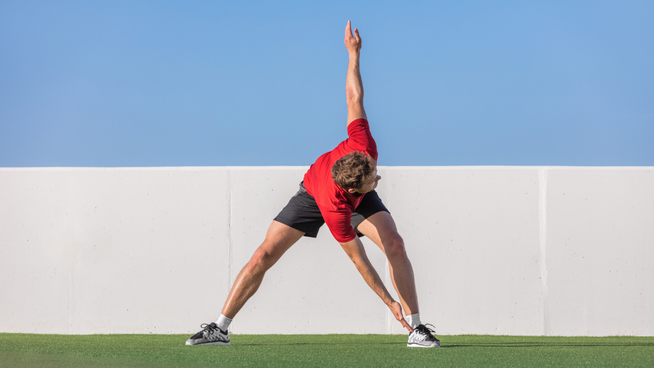
6. Figure-Four Stretch
Lie face up, knees bent.
Cross left ankle over right knee.
Lace fingers behind left hamstring, gently pull right leg toward you for a stretch in the left hip.
Hold, then repeat on the other side for 5 reps per side.

7. Quadruped to Downward Dog
Start on all fours, arms at shoulder width, toes tucked.
Lift knees, and push hips up and back into downward dog.
Lengthen spine, relax neck, and straighten legs as comfortably.
Lower back to all fours, repeat for 10 reps.

8. Modified Brettzel Stretch
Lie face up, bend right knee to 90 degrees, and rotate it over left leg to the ground.
Place left hand on right knee, extend right arm out to the side.
Swoop right arm overhead and around to meet left, stacking shoulders.
Reverse motion, keeping the right knee down.
Do 5 reps per side.
9. Lunge to Rotation
Stand feet hip-width apart.
Step right foot forward into a lunge, hinge forward, and plant left hand on the ground.
Rotate torso right, extend right arm to the ceiling.
Return arm down, stand up, repeat on left.
Alternate for 10 reps (5 per side).

10. Straight Leg Walk Outs
Stand tall, hinge at hips, walk hands out to a high plank, keeping legs straight.
Squeeze glutes and core.
Walk hands back to standing, legs stay straight.
Repeat for 8–10 reps
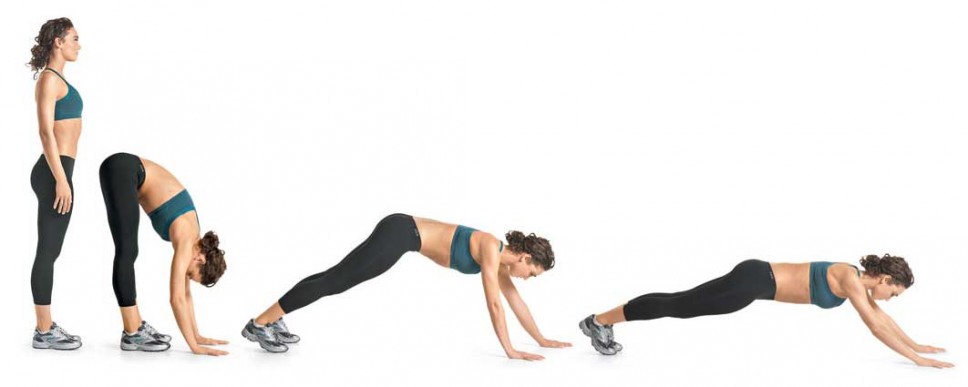
3 Full-Body Mobility Exercises for Runners
Here are 3 mobility exercises that target not only the legs. These include ankle and spine mobility, core, hips, and upper body. Such multi-step exercises are perfect for runners who want to move better, prevent injuries, and improve performance
1. World’s Greatest Stretch (Enhanced Version)
Targets: Hips, hamstrings, thoracic spine, shoulders
It’s a dynamic, multi-joint movement that mimics running mechanics while opening tight areas.
How to do it:
- Starting position: push-up.
- Step your right foot outside your right hand into a deep lunge.
- Drop your left knee and rotate your torso open, reaching your left arm to the sky (keep your right elbow inside your right foot).
- Hold for 2 seconds, then return to push-up position.
- Repeat on the other side.
Reps: 5 per side
Pro tip: Move slowly — this isn’t about speed, but control.
2. Bear Crawl to Scorpion Reach
Targets: Hips, core, shoulders, and spinal rotation
Builds rotational mobility (key for arm swing) and hip/shoulder stability, plus, this is a great hip mobility exercise.
How to do it:
- Starting position: on all fours in a “bear crawl” pose (knees hovering 1 inch off the ground).
- Crawl forward 3 steps, then reach your right hand toward your left foot while twisting your torso (like a scorpion tail).
- Return to bear crawl, crawl 3 more steps, and repeat on the other side.
Reps: 4 reaches total (2 per side)
Pro tip: Keep your hips low to engage your core.
3. Inchworm to Down Dog Pedal
Targets: Hamstrings, calves, shoulders, spine
Stretches the posterior chain while improving shoulder and ankle mobility.
How to do it:
- Stand tall, then fold forward and walk your hands out to a push-up position.
- Push your hips up into Downward Dog.
- Pedal your feet (alternately bending each knee) to stretch your calves/hamstrings.
- Walk your hands back to your feet and roll up to standing.
Reps: 4–5
Pro tip: In Down Dog, focus on pushing your chest toward your thighs.
Common Mistakes to Avoid During Mobility Training
When you incorporate a gentle mobility routine into your training plan, make sure you avoid these common triathlete mistakes:
1. Confusing Mobility with Static Stretching
❌ As I have mentioned earlier in the article, mobility exercises and stretching are not the same. They serve different purposes and do not target your muscles in the same way. Hence, avoid holding long static stretches before a run (e.g., touching toes for 30 seconds).
✅ Before the run, try to focus on dynamic mobility instead, do exercises like leg swings, lunges with twists. Save static stretching for post-run or off-days.
Why? Static stretching pre-run can temporarily weaken muscles, while dynamic moves prep tissues for movement.
2. Ignoring Active Control
❌ When doing mobility exercises, you should fully control your motions. Do not just flop into stretches passively (e.g., bouncing in a hamstring stretch).
✅ Engage your muscles and practice mind-muscle connection, for instance, in a hip flexor stretch, gently squeeze your glute to deepen the stretch safely.
Mobility requires strength within the new range of motion. Otherwise, you’re just stretching ligaments, not improving your movement.
3. Skipping the Feet & Ankles
❌ Many runners make this mistake: they focus solely on their hips and hamstrings while neglecting their feet. But your feet are the foundation of every stride. If they lack mobility and strength, it can throw off your running cadence and alignment.
✅ Make sure you add feet and ankle-targeted exercise like towel toe curls, ankle CARs, or single-leg balance drills to every session.
Incorporating these can reduce the chances of injury as stiff ankles force your knees/hips to compensate, increasing injury risk.
4. Overdoing Extreme Ranges
❌ There is no need to force yourself into the exercise when you feel pain. For example, you should not force a deep squat or a split without proper progression.
✅ Instead, use props, such as yoga blocks, and build range gradually.
Why? Aggressively pushing into end ranges can irritate joints, especially for runners with existing wear and tear.
5. Neglecting Symmetry
❌ Another mistake is only working on your “tight” side or favoring one leg.
✅ You should compare sides (e.g., test ankle dorsiflexion on both feet) and address imbalances.
Why? Asymmetries lead to compensatory patterns (e.g., hip drop, IT band pain).
6. Rushing Through Movements
❌ Mobility drills are not cardio, so do not rush them.
✅ FSlow down! Pause for 2–3 seconds in stretched positions to breathe deeply and feel the stretch.
Controlled tempo builds neuromuscular control, which is critical for running efficiency.
7. Inconsistent Breathing
❌ Try not to hold your breath during challenging positions.
✅ Exhale deeply when moving into a stretch (e.g., breathe out as you sink into a lunge).
Breath helps relax muscles and access deeper ranges safely.
8. Skipping Post-Run Mobility
❌ Pre-run warm-up is as much important as post-run stretches, although both are often ignored, let’s admit it.
✅ Next time, after your run, try to spend 5 minutes on:
- Calf smashing (with a lacrosse ball)
- Psoas release (half-kneeling over a foam roller)
- Gentle flows (e.g., cat-cow to child’s pose)
Post-run mobility reduces stiffness and resets muscle length.
Need a simple mobility checklist? Try this:
- Pre-Run: Dynamic moves (leg swings, Spiderman reaches)
- Post-Run: Foam rolling + gentle stretching
- Off-Days: Strength + controlled mobility (Cossack squats, hip CARs)
Let me know if you want a personalized mobility assessment based on your running form!
Closing Thoughts
It doesn’t happen overnight, but consistency can make a real difference in how you move, feel, and perform as a runner.
Mobility work helps your joints move more freely, reduces stiffness, and allows your muscles to fire in better coordination. Over time, this can mean better running efficiency, fewer overuse injuries, and quicker recovery after tough workouts or long runs.
Do a combination of dynamic mobility drills before your runs and static stretching or gentle mobility flows after, and you’ll maintain a healthy range of motion and prevent the buildup of tightness that leads to compensation and strain.
Think of mobility training as an investment: the time you put in now will pay off in smoother strides, fewer injuries, and more enjoyable runs. Be consistent, listen to your body, and give it what it needs to run well.
